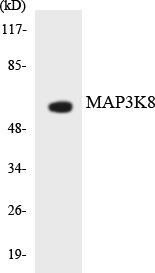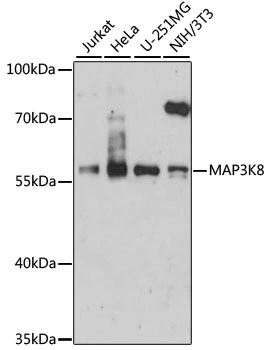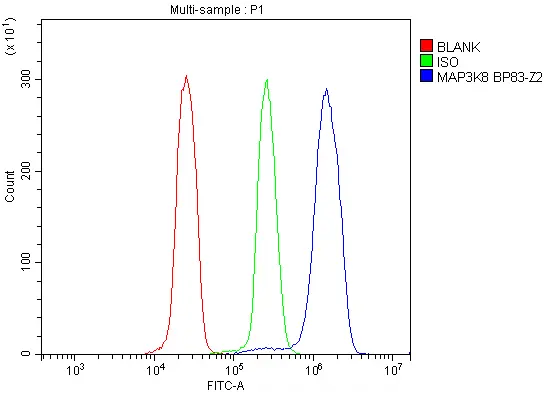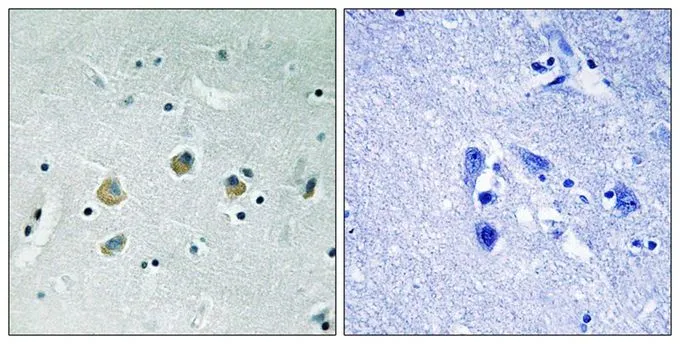MAP3K8 antibody [N3C3]
GTX102711
ApplicationsImmunoFluorescence, Western Blot, ImmunoCytoChemistry, ImmunoHistoChemistry, ImmunoHistoChemistry Paraffin
Product group Antibodies
ReactivityHuman, Mouse
TargetMAP3K8
Overview
- SupplierGeneTex
- Product NameMAP3K8 antibody [N3C3]
- Delivery Days Customer9
- Application Supplier NoteWB: 1:5000-1:50000. ICC/IF: 1:100-1:1000. IHC-P: 1:100-1:1000. *Optimal dilutions/concentrations should be determined by the researcher.Not tested in other applications.
- ApplicationsImmunoFluorescence, Western Blot, ImmunoCytoChemistry, ImmunoHistoChemistry, ImmunoHistoChemistry Paraffin
- CertificationResearch Use Only
- ClonalityPolyclonal
- Concentration0.33 mg/ml
- ConjugateUnconjugated
- Gene ID1326
- Target nameMAP3K8
- Target descriptionmitogen-activated protein kinase kinase kinase 8
- Target synonymsAURA2, COT, EST, ESTF, MEKK8, TPL2, Tpl-2, c-COT, mitogen-activated protein kinase kinase kinase 8, Ewing sarcoma transformant, augmented in rheumatoid arthritis 2, cot (cancer Osaka thyroid) oncogene, proto-oncogene c-Cot, proto-oncogene serine/threoine protein kinase, tumor progression locus 2
- HostRabbit
- IsotypeIgG
- Protein IDP41279
- Protein NameMitogen-activated protein kinase kinase kinase 8
- Scientific DescriptionThis gene was identified by its oncogenic transforming activity in cells. The encoded protein is a member of the serine/threonine protein kinase family. This kinase can activate both the MAP kinase and JNK kinase pathways. This kinase was shown to activate IkappaB kinases, and thus induce the nuclear production of NF-kappaB. This kinase was also found to promote the production of TNF-alpha and IL-2 during T lymphocyte activation. Studies of a similar gene in rat suggested the direct involvement of this kinase in the proteolysis of NF-kappaB1,p105 (NFKB1). This gene may also utilize a downstream in-frame translation start codon, and thus produce an isoform containing a shorter N-terminus. The shorter isoform has been shown to display weaker transforming activity. [provided by RefSeq]
- ReactivityHuman, Mouse
- Storage Instruction-20°C or -80°C,2°C to 8°C
- UNSPSC12352203
References
- Peterson AF, Ingram K, Huang EJ, et al. Systematic analysis of the MAPK signaling network reveals MAP3K-driven control of cell fate. Cell Syst. 2022,13(11):885-894.e4. doi: 10.1016/j.cels.2022.10.003Read this paper
- Liu Y, Li Y, Zhang D, et al. Mitogen-Activated Protein Kinase 8 (MAP3K8) Mediates the Signaling Pathway of Estradiol Stimulating Progesterone Production Through G Protein-Coupled Receptor 30 (GPR30) in Mouse Corpus Luteum. Mol Endocrinol. 2015,29(5):703-15. doi: 10.1210/me.2015-1009Read this paper







